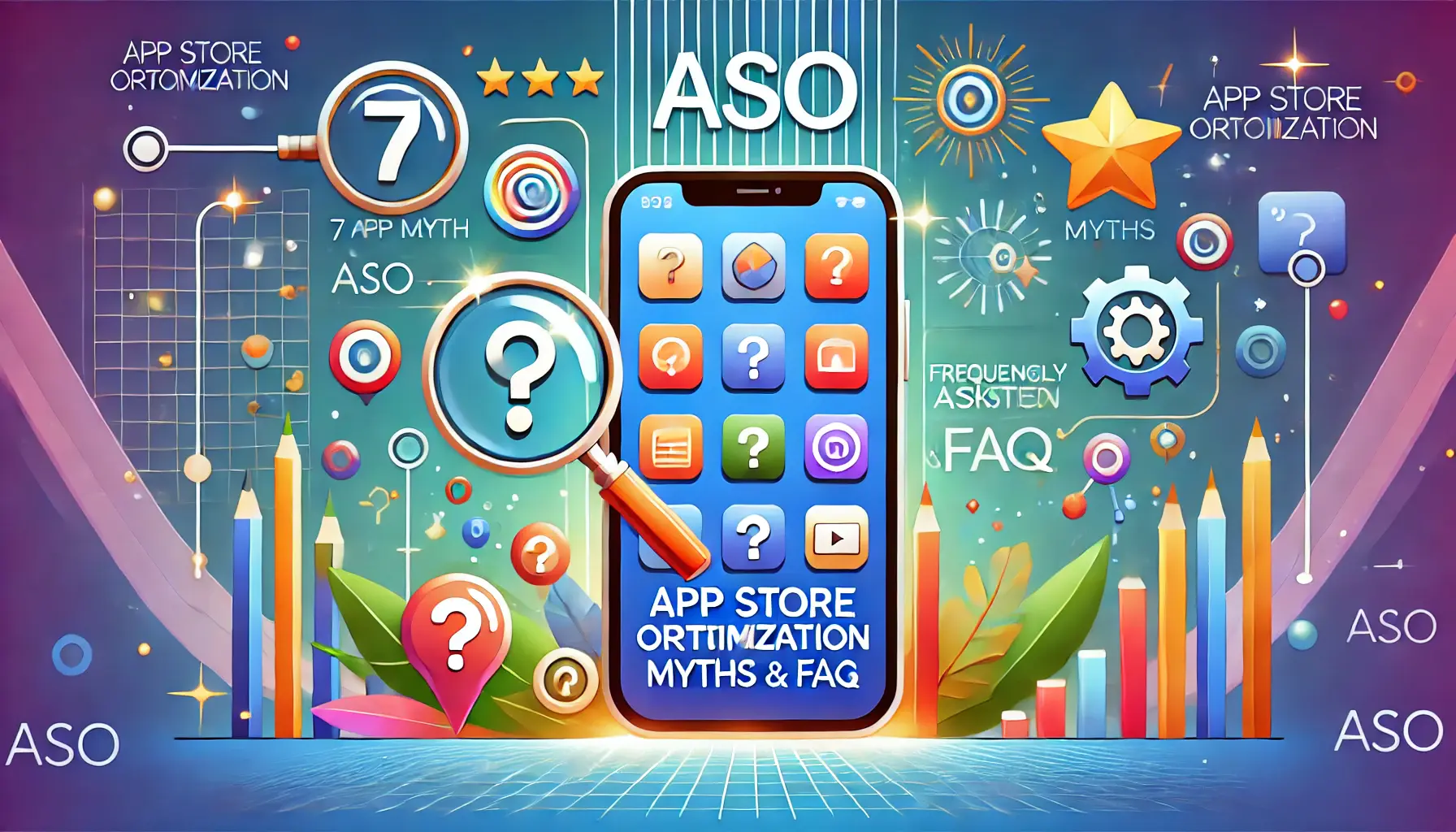Discovering your app from millions of apps in the searches is crucial for users, and it becomes more competitive on a daily basis with all available projections in App Store Optimization (ASO).
Millions of apps exist, so how can you ensure that yours gets noticed?
Enter App Store Optimization (ASO).
ASO is very important for your app to get visibility, downloads, and increase the engagement of users.
Learning ASO strategies will enable you to make your app rank higher in app store searches and grab the attention of potential customers.
In this article, we will take you through all the developments in ASO 2024 and also actionable tips to increase your app visibility through effective ASO techniques.
I’m going to take you through the basics of ASO, explain ASO, and highlight how important it is for your app’s success.
ASO (App Store Optimization) is the process of improving an app’s visibility in app stores, similar to how SEO (Search Engine Optimization) improves website visibility in search engines.
The Basics of ASO to Improve App Performance
What is ASO?
App Store Optimization (ASO for short) involves optimizing your app listing to improve its visibility on an Apple App Store or Google Play.
In a nutshell, ASO helps your app be more easily discovered in search results and therefore easier to install, helping boost your ASO performance.
ASO is not just a matter of visibility but of conversion rateThe percentage of users who download or engage with the app after viewing it in the app store., too.
When you have done a great job with ASO optimization, the right users end up discovering your app and consequently downloading it.
If they found it in searches, it means that there are more chances of those users being genuinely interested in your app.
Okay, so why does 2024 matter at all in the world of ASO?
Keeping pace with the evolving world of mobile apps and changing algorithms of app stores, one needs to chalk out a comprehensive strategy for ASO success.
This is why a strong part of just about any app marketing strategy always includes some form of App Store Optimization.
Here are three main reasons that make your ASO effective:
- Better visibility: The better ranked your app is in search results, the more visible you are to users.
- Enhanced download rates: Optimization of apps for the app store results in a higher number when it comes to downloads.
- Cost-effectiveness: ASO, unlike paid ads, works for you in an organic way so that users come to you on their own.
- Competitive advantage: Thousands of apps are competing against each other, and ASO can give you that competitive edge.
In the mobile app world, there are some basic ASO fundamentals you should understand, as they will form the foundation of your off-site strategy.
The question is, how do you determine success in ASO?
Start by tracking the appropriate ASO metrics and analyzing their impact on your app’s performance.

Visual representation of ASO keyword research and optimization, illustrating the connection between keyword discovery, app performance, and optimization.
ASO Keyword Research and Optimization
Keyword research is one of the most important parts of App Store Optimization (ASO).
Without the right keywords, your app will never get discovered by potential users.
The best-performing apps A/B testA method of comparing two versions of an app or its elements to see which performs better in terms of user engagement and conversions. components such as app titles and keywords (which they have already researched and optimized for) in order to be visible in relevant searches, increasing the odds of someone downloading your app.
So today, we will discuss the best keywords for ASO in 2024.

Visual representation of the process of picking relevant keywords for your app’s success in ASO.
Picking Keywords for Your App
Choosing the right keywords is the cornerstone of a robust ASO strategy.
Consider how your potential app users would search for an app like yours.
Think about other terms and phrases that can describe your app’s main functionality.
- Keywords relevance: Ensure that your selected keywords are directly aligned with your app. Having your app show up under irrelevant keywords can get you views, but they will not produce conversions.
- Search volume: Search for keywords with reasonable search volume and ignore top searches with high competition.
- Competition: While high-volume keywords seem attractive, they come with steep competition. Opt for a blend of high and low competition keywords.
The key to keyword research for ASO is finding a happy medium between search volume and competition so that your app appears in searches, but for the right reasons.

Representation of tools used for keyword research and performance tracking in ASO.
ASO Keyword Research Tools
Even if you have more time to work on it, there are plenty of options for refining keyword research.
Here are some of the most used ASO keyword research tools:
- App Radar: This tool is an incredible app store optimization platform that deals with keyword analysis and suggestions.
- Sensor Tower: This tool provides you with a comprehensive analysis of keywords, showing how they are performing and trending.
- Mobile Action: Another tool that enables you to analyze competitor keywords while offering performance tracking of their app.
Using these tools properly can give you a better overview of how your keywords are performing and help identify areas where further tweaks are needed to boost your app’s visibility.

Illustration of the importance of placing keywords in the title and description for better app store optimization.
Using Keywords in the Title and Description of Your App
Once you’ve identified the best keywords for your app, it’s time to use them strategically in both your title and description.
One crucial part of using keywords is in your actual app title because this has a major bearing on search rankings.
Adding naturally integrated keywords into your app’s description makes it easier for the algorithms to understand whether your app should appear in search results.
Just be careful not to go overboard with keyword stuffing.
Your keywords should read naturally and fit into your app listing well.

Visual representation of localizing keywords for global success in app store optimization.
Localizing Keywords for Global Success
Another key factor in ASO keyword optimization is localization.
If your app is available in multiple countries, then keyword localization for those regions is crucial.
However, mere translation of your current keywords is not the answer.
Instead, concentrate on finding search terms that people in different countries are most likely to use.
Localization broadens the reach of your app and ensures its viability across various regions, making your app more likely to be downloaded on a global scale.

Representation of optimizing app metadata for better visibility in app store search results.
Optimizing App Metadata for Increased Visibility
App metadataInformation that describes the contents of an app, such as title, description, and visuals, used to help the app store understand and categorize the app. is one of the most important aspects of App Store Optimization (ASO).
Optimizing metadata allows your app to have better visibility and ranking on search results within the app store.
Your metadata consists of your app name, description, as well as screenshots and videos—all of these elements work together to craft an attractive listing that will lure potential customers in.
Let us take a deep dive into the sub-modules of metadata optimization for ASO in 2024.

Illustration of the process of writing app descriptions that lead to higher conversions and engagement.
How to Write High-Converting App Descriptions
The app description is one of the first things users will read when checking out your app, so it needs to not only provide information about what your app does but also sell users on why they should try or purchase the app.
To write a better app description for conversion, list the core functionalities and promising features your app will deliver.
Highlight your app’s unique points and explain why users should choose your app over others.
With a clear and concise description, using your target ASO keywords effectively, you can increase your visibility to the right audience and boost downloads.
- Brevity is a virtue: Get straight to the point—avoid going into unnecessary details.
- Bullet points: Use bullet points to highlight key facts in short phrases for better readability.
- User benefit appeal: Describe the specific problem your app solves and how users will benefit from using it.

Illustration highlighting the importance of screenshots and videos in enhancing app visibility and conversions for ASO.
Why Are Screenshots and Videos Important for ASO?
Visuals—screenshots and videos—are crucial components of your app metadata.
High-quality visuals don’t just show how your app looks but also demonstrate to users what they can expect from using it.
Here’s a fact: using eye-catching screenshots and engaging videos can dramatically boost your conversion rates.
To showcase your app in the most ASO and user engagement-optimal way, ensure that your visuals demonstrate the app’s features in action.
- Show-it-all: Make sure your screenshots highlight the key features of your app.
- Make it interesting: Use videos to present your content in an engaging way that attracts users to download your app.

Representation of crafting the perfect app title and subtitle for better visibility and success in ASO.
How to Write a Perfect App Title & Subtitle
Your app title and subtitle are not only important for visibility in ASO but also for branding.
The title is often the first thing users notice, and it significantly influences search rankings on app stores.
Most organic app store searches are driven by keywords in your title, so it’s crucial to get this right!
Incorporate primary ASO keywords into your app title, while the subtitle can serve as an additional space for secondary keywords or to highlight your app’s unique selling point (USP).
Remember, your title and subtitle should be catchy, communicate the main reason why users should download your app, and strategically incorporate ASO keywords.
Illustration showcasing the importance of optimizing app icons for better user engagement and appeal.
Optimizing Your App Icon for Better Engagement
Your app icon plays a critical role in conversion rates—it serves not only as a visual identifier but also as a key factor in whether users download your app.
A well-designed icon can make the difference in a competitive market, helping your app stand out and instantly communicate its purpose to potential users.
Optimize your app icon for engagement by using robust visuals and vibrant colors that appeal to your target demographic.

Illustration of A/B testing as a tool for optimizing app elements and improving ASO.
A/B Testing That Works for ASO
In ASO, A/B testing of metadata is one of the most effective tools at your disposal.
By testing different versions of your app title, description, screenshots, and even the app icon, you can see which elements perform best in terms of visibility and conversion rates.
Regular A/B testing ensures that your app listing is always fully optimized for ASO success in 2024.
- Look at granular aspects: Whether it’s the app title or the icon, individually test each element to see what performs better.
- Assess the data: Use performance data to determine whether one version is worth implementing over another.
- Continual iteration: Use the results of your A/B tests to refine your app’s metadata and continually improve its performance.
Using visually appealing app icons and screenshots can drastically increase conversion rates, as users are more likely to engage with apps that look polished and professional.

Representation of how reviews and ratings can improve app visibility and performance in ASO.
Use Reviews and Ratings for ASO
App Store Optimization (ASO) is not just a form of user feedback or reviews.
Good reviews are not only important for the ASO algorithm of each particular platform but also can greatly influence potential users’ decisions.
Use reviews effectively, and you can significantly improve the visibility and reputation of your app.
So, what makes the best use of reviews and ratings for ASO in 2024?

Visual representation of how positive reviews can boost app store rankings for better visibility and performance.
Effect of Reviews on ASO Rankings in App Stores
Adopting a strong review strategy is a great way to improve your app’s reputation and increase the quality of app store ratings.
The better and more reviews you have, the higher your app will rank in search results.
This also encourages more potential users to download your app, as it demonstrates that many people are using the app and finding value in it.
As a result, a high rating equals more success in improving your overall ASO strategy.
- Rankings get a boost: Positive reviews can help improve your app’s ranking in the app store, leading to more exposure to users.
- Social proof: A 5-star rating and great comments make it easier for new users to trust and download the app.

Visual representation of how addressing negative reviews can turn them into positive feedback, enhancing app performance.
Prompting Positive Reviews and Handling Negative Ones
Encouraging positive reviews takes a proactive approach.
Ask users to leave a review after a positive experience and use in-app feedback prompts.
Responding promptly and professionally to negative reviews shows that you take user concerns seriously, which can help retain users.
In some cases, this can turn a negative review into a positive one, which can help refresh your app’s rating.
- Request reviews: Use in-app prompts to ask happy users to leave a rating and review.
- Review comments: Address negative feedback and provide solutions to resolve the problem.
- Provide updates: When a user’s issue has been resolved, notify them with updates and improvements, earning their trust and possibly changing their review.

Visual representation of how user feedback can improve app performance and ASO success.
How User Feedback Can Help ASO
User feedback is invaluable for optimizing your app and improving its ASO ranking.
By collecting feedback, you can see what changes need to be made to improve user satisfaction.
Listening to your users and making regular improvements, whether through adding features or fixing bugs, ensures that your app stays relevant and continues to evolve in a competitive market.
- Spot recurring issues: Use feedback to identify recurring issues or pain points that need to be addressed.
- Implement changes: Regular app updates based on user feedback can improve the overall user experience and boost ratings.
- Remain competitive: Ongoing improvements help your app remain relevant and competitive in the app market.

Illustration of the process of monitoring and responding to app reviews for ASO success in 2024.
Review Monitoring and Response in 2024
Monitoring your reviews regularly is essential for your ASO efforts.
Keeping track of both positive and negative feedback allows you to respond promptly and build a positive relationship with your users.
In 2024, review monitoring tools make it easier to manage and respond to reviews effectively.
- Review tracking: Utilize monitoring tools to stay informed about what users are saying and to track valuable insights.
- Quick responses: Fast responses show users that their opinions matter to you and that you are actively working to improve your app.
- Maintain a positive relationship: Engaging with both positive and negative feedback helps build trust with your users and improves overall user satisfaction.
Remember that responding promptly to both positive and negative reviews demonstrates that you value user feedback, which can enhance your app’s reputation and improve ASO performance.
Representation of continuous growth tracking and strategic iteration for app store optimization (ASO).
Strategic and Iterative ASO Growth Tracking
The very implementation of your App Store Optimization (ASO) strategy is key to continued success, but tracking how it performs over time is crucial for growth.
Remember that ASO is a marathon, not a sprint, and you will always need to monitor, refine, and analyze your strategy to keep your app visible in the app store and ensure continuous growth.
In this section, we are going to discuss how you can adequately measure and improve your ASO strategy for future growth in 2024.
Representation of the tools used for tracking and optimizing ASO performance.
ASO Performance Tracking Tools
Measure your ASO performance by using tools that help you track different KPIs such as keyword rankings, downloads, conversion rates, and user engagement.
These tools will give you insights into how well your app is performing in the app store and highlight areas that need improvement.
- App Annie: Allows you to track an app’s performance over time, including keyword rankings, downloads, and revenue trends.
- Sensor Tower: Provides in-depth app store ranking, keyword tracking, and competitor analysis for a holistic overview of your ASO results.
- Mobile Action: Offers ASO metrics analysis, competitor monitoring, and actionable insights for growth.

Illustration representing the continuous process of optimizing your ASO strategy over time.
How Frequently to Optimize Your ASO Strategy
Whether your app is performing well or facing challenges, market trends and algorithm changes will determine how often you need to update your ASO strategy.
Generally, you should revisit and update your strategy every few months to stay competitive.
However, if you see significant drops in rankings or user engagement, it’s worthwhile making adjustments sooner.
- Update regularly: Every few months, update your keywords, metadata, and assets to stay ahead of competitors and keep up with app store algorithm changes.
- Apply your data: React to performance data, and when you see a decline, base your actions on the insights gained.
- Seasonal changes: Keep your app listing updated for seasonal events or trends to match popular search terms.

Illustration of how apps adapt to algorithm changes in app stores to maintain performance and visibility.
Adapting to Algorithm Changes in App Stores
App store algorithms change frequently, meaning your ASO strategy could become outdated overnight.
Ensuring that your app stays competitive requires staying up to date on app store algorithm updates and ASO best practices.
- Stay informed: Keep up with app store updates and industry news to anticipate algorithm changes and stay ahead.
- Try new tactics: Test changes in keywords, metadata, or creative assets to adapt to algorithm updates and stay relevant.

Illustration showcasing how analytics drive powerful ASO results through data analysis and optimization.
Why Analytics Is a Hidden Weapon for Powerful ASO Results
Analytics are vital to fine-tuning your ASO strategy.
Once you have performance data, identifying what works and what needs improvement becomes much easier.
Using analytics in app store optimization helps track your app’s progress from keyword performance to conversion rates, allowing for data-driven decisions that ensure the best visibility and success for your app.
- Conversion rate monitoring: Track how well your app converts views into downloads to measure the effectiveness of your ASO strategy.
- Analyze keyword performance: Identify your best-performing keywords and optimize your metadata to capitalize on them.
- Employ cohort analysis: Break down your user data into cohorts to better understand user behavior and adjust your ASO efforts accordingly.

Illustration of mastering ASO for success in the evolving app store optimization landscape of 2024.
Mastering ASO for Success in 2024
As you already know, App Store Optimization (ASO) is crucial for ensuring that your app can be seen and found in the vast jungle of millions—maybe even billions—of apps available in 2024.
The bottom line is to absolutely nail the planning stage and then rigorously test new tactics while adjusting your strategy in response to market changes or algorithm updates.

Illustration of the key takeaways for achieving success in app store optimization.
Key Takeaways for ASO Success
To maintain sustainable success in the long run, you need to be proactive, reactive, and data-driven.
Here are the major key points you need to remember for executing a successful ASO strategy:
- Learn the basics: Perfect your ASO skills by mastering everything from keyword research to metadata optimization, both of which play a strong role in boosting your app’s visibility on the app store.
- Leveraging powerful tools: If your app is already live, it becomes imperative to track its performance and tweak your ASO strategy accordingly by using tools like App Annie, Sensor Tower, or Mobile Action.
- User feedback: Harness positive reviews and ratings to improve app rankings while promptly addressing negative feedback.
- Regular updates: Consistently update your plan to stay viable and aligned with algorithm changes through regular checks on keywords, metadata, and assets.
- Relevant analytics and A/B testing: Use the right metrics to make data-driven decisions that enhance your app’s performance, helping you to quickly identify what works and what doesn’t.

Illustration of sustainable growth achieved through ongoing ASO refinement and optimization.
Sustainable Growth through Continuous ASO Refinement
App Store Optimization is a continuous process, not just something you do once.
You need to be adaptable, constantly adjusting as user behavior changes, market trends evolve, and app store algorithms shift.
Keeping your ASO strategy up to date with new results, information, and performance data is key to maintaining your app’s success over time.
Regularly monitor your app’s performance and optimize for conversion rates as part of your ongoing ASO efforts.
Some adjustments will be driven by seasonal shifts, some by changes in algorithms, and others by user feedback—all of which can impact how and where your app is seen and downloaded.

Illustration of how ASO strategies can secure long-term success and growth for your app.
How ASO Will Secure Your App’s Future
At the end of the day, App Store Optimization is essential if you want to stay on top.
In a market that is massively overcrowded, having a well-established ASO strategy will make your app stand out from the competition, leading to more downloads and better user retention.
The better optimized your app is in the app store, the more likely it is to achieve long-term growth.
Through proper ASO—from keyword optimization to user engagement—you set your app up for success, ensuring its long-term viability well into the future.
Adapt, stay abreast of emerging industry trends, and continue to refine your ASO strategy throughout 2024 and beyond.

Illustration addressing myths and FAQs related to App Store Optimization (ASO) with clarification and insights.
Boost your mobile app's success with our guaranteed App Store Optimization (ASO) service. Leave it to the experts!
7 App Store Optimization (ASO) Myths and FAQs
We have compiled some of the frequently asked questions to help you better understand and execute App Store Optimization (ASO) in 2024 for optimal results in the Apple App Store.
ASO (App Store Optimization) is the art of optimizing your app’s metadata, similar to SEO for websites, to improve visibility when people search for apps in a specific category on the app store.
With over 1.6 million apps in the app stores, ASO is crucial to help your app stand out, improve discovery, and boost rankings and conversion rates, leading to more downloads in a competitive market.
Update your ASO strategy every 3-6 months or when there are significant changes in market trends, user behavior, or app store algorithms that impact your app’s performance.
Top tools for monitoring ASO performance include App Annie, Sensor Tower, and Mobile Action.
These tools help track key metrics such as keyword rankings, downloads, and user engagement to optimize your ASO strategy.
User reviews and ratings are essential for ASO.
Positive reviews boost app rankings and encourage new users to install your app, while addressing negative feedback helps retain your user base and maintain your reputation.
The key elements of a successful ASO strategy include keyword research, metadata optimization (title, description, visuals), regular updates, leveraging user feedback, and using analytics to refine your strategy.
Yes, by localizing your app’s keywords and metadata for different regions, ASO helps your app rank higher in various countries, improving visibility and increasing downloads on a global scale.
A/B testing allows you to experiment with different metadata, keywords, and visuals to identify which elements perform best, refining your ASO strategy to convert more organic traffic into downloads.
ASO focuses on optimizing your app’s visibility within the app store search results, while SEO (Search Engine Optimization) is focused on improving a website’s visibility on search engines like Google.













